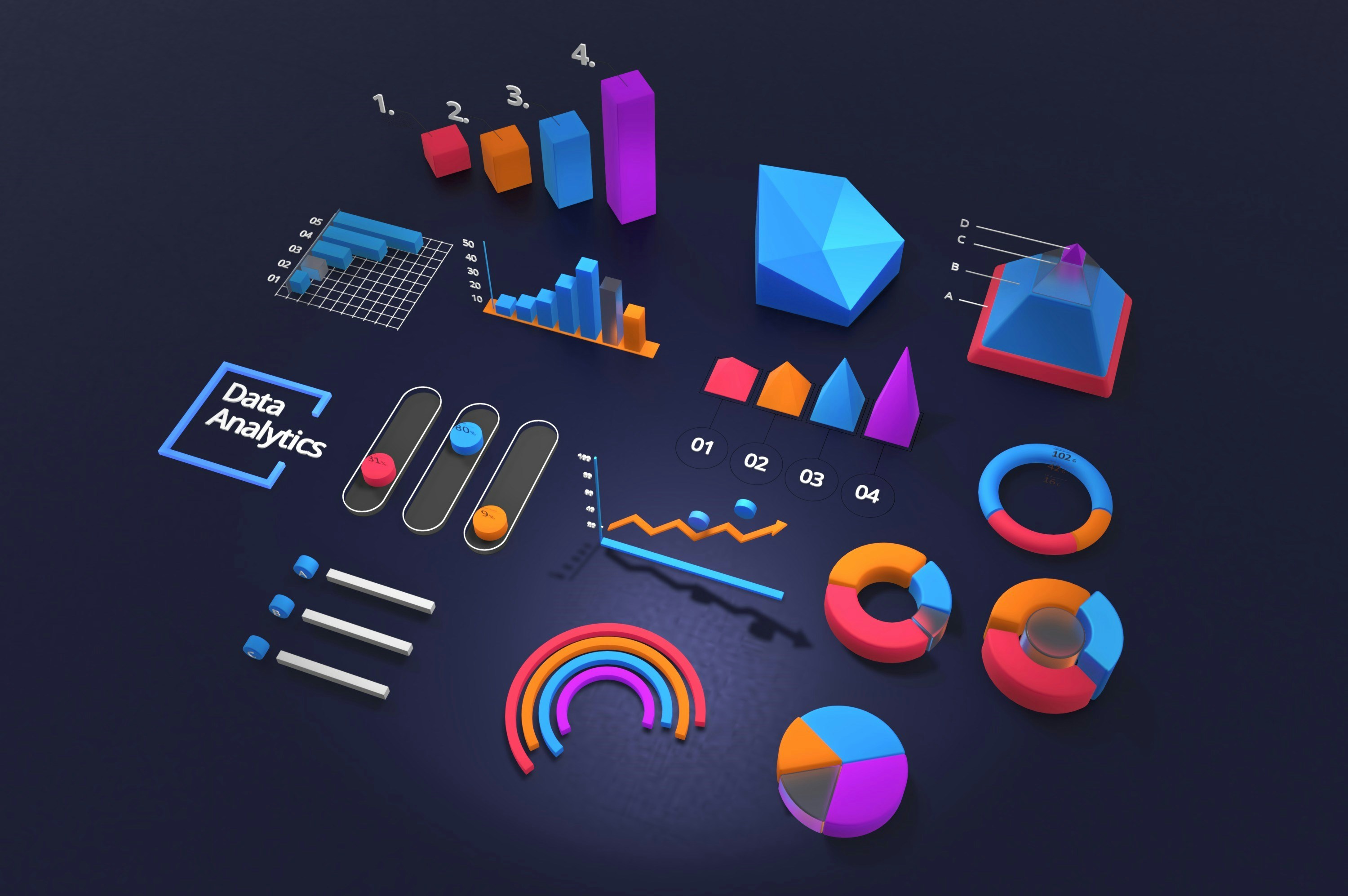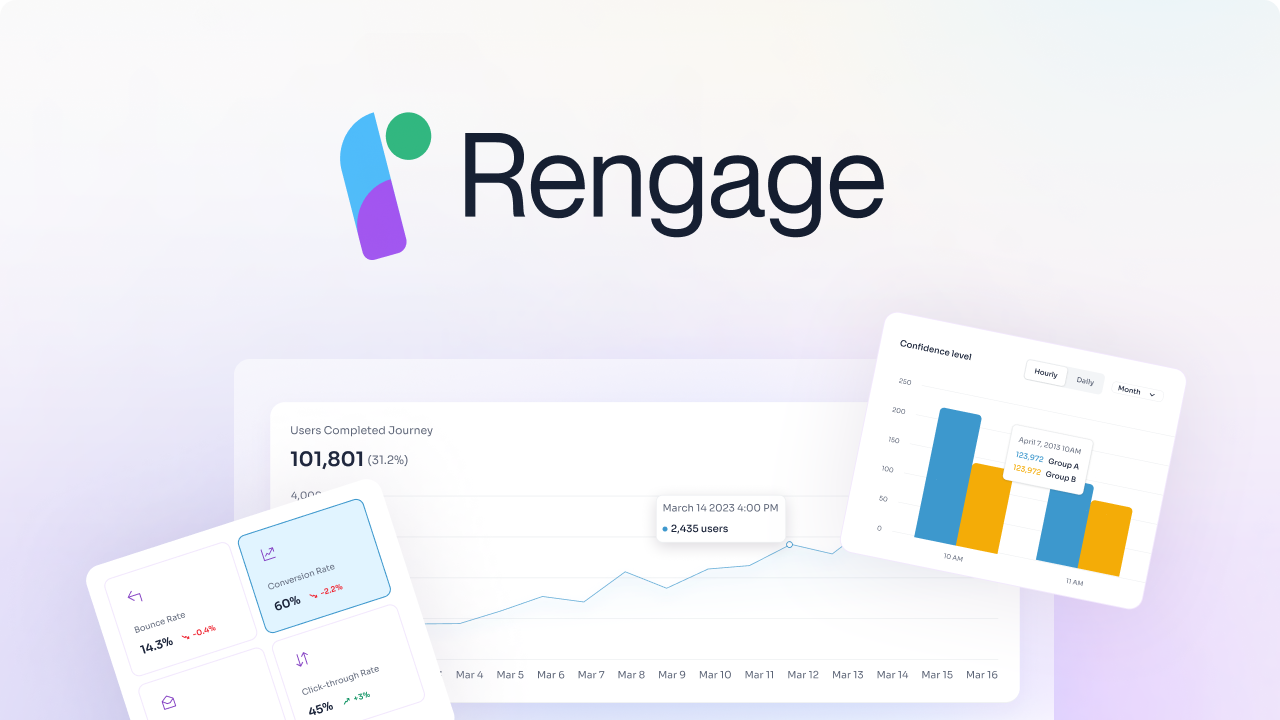Do you find yourself stuck on the same old traditional methods of customer segmentation analysis? If so, it might be time to consider exploring alternative segmentation techniques. We'll explore alternatives to Segment that might just be the solution you've been looking for to help engage your target audience and drive business growth.
Looking for a tool to help you achieve your segmentation goals, such as learning 10 alternatives to segment? Try Rengage's solution. Drive loyalty and growth with an excellent tool that will help you segment your audience in new and innovative ways, transforming your business strategies.
Table of Contents
- What is a Customer Data Platform?
- What is Segment (as a CDP tool)?
- Top 10 Segment Alternatives
- Factors to Consider When Choosing a Segment Alternative
- Industry Trends of Customer Data Platforms
- Create Personalized Experiences That Drive Loyalty and Growth with Rengage — Book A Free Demo Today
What is a Customer Data Platform?

Collecting information
A CDP collects data from various sources, such as websites, social media, emails, and in-store purchases. It's constantly collecting data, ensuring it always has the most up-to-date customer information.
Putting it all together
Once the data is gathered, the CDP organizes it, creating a cohesive image of each customer. By combining different data points about a customer, the CDP helps companies build a comprehensive view of each customer.
Making it easy to use
CDPs offer easy access to organized customer data for different company teams, such as marketing, customer service, and sales. They are a well-organized library where employees can quickly find information.
Helping make smart decisions
With organized customer data, companies can make informed decisions about how to engage with customers, what products to offer, and how to improve customer satisfaction. Businesses can tailor their interactions by analyzing customer behavior to each customer's preferences.
Keeping things up-to-date
As customers' preferences and behaviors evolve, the CDP ensures that customer data is always current. This continuous updating ensures companies have the most relevant information to tailor their offerings and communications effectively.
Segment customers
CDPs help segment customers based on shared characteristics or behaviors. This segmentation allows businesses to customize their marketing and services to different customer groups. For example, businesses can group customers as frequent online shoppers or eco-friendly product enthusiasts.
Predict future behavior
By analyzing trends in customer data, CDPs can predict future customer behavior. This predictive capability empowers businesses to proactively anticipate customer needs and address potential issues.
Personalize experiences
With detailed customer information, CDPs enable businesses to provide personalized experiences to customers. This could involve showcasing different website content or sending customized email offers based on individual preferences.
Protect privacy
CDPs help companies responsibly handle customer data, ensuring that data protection laws are followed and customer privacy preferences are respected.
Measure results
CDPs track the effectiveness of various marketing campaigns and customer service initiatives. This tracking enables businesses to gauge their efforts' success and identify improvement areas.
Related Reading
- Customer Data Infrastructure
- Omnichannel Analytics
- Customer Data Integration
- Predicting Customer Behavior
- Marketing Data Platform
- Customer Data Platform Vs Data Management Platform
- Customer Data Platform Use Cases
- Best Customer Data Platform
- Customer Data Platform Capabilities
- Customer Data Platform Tools
- How To Choose Cdp
What is Segment (as a CDP tool)?

Segment Overview
Segment is a leading customer data platform (CDP) designed to streamline customer data collection, unification, and activation for businesses across various industries. Here’s an in-depth look at Segment, highlighting its functionalities, benefits, and target market:
Functionality of Segment
Segment is a robust infrastructure that facilitates seamless data integration and management across multiple channels and touchpoints. Key functionalities include:
Data Integration
Segment connects data sources such as websites, mobile apps, marketing tools, and CRM systems. It aggregates data in real-time, ensuring that businesses have access to the most current customer information.
Data Cleaning and Unification
It standardizes and cleans incoming data to ensure consistency and accuracy. By resolving identifiers and merging duplicate records, Segment creates unified customer profiles that provide a holistic view of each customer.
Data Routing
Segment routes cleaned and enriched data to businesses' various marketing and analytics tools. This capability enables seamless data activation across different platforms without repetitive integrations.
Benefits of Using Segment
Implementing Segment offers several strategic advantages for businesses aiming to optimize customer data utilization and enhance marketing effectiveness:
Single Customer View
By consolidating data from disparate sources, Segment creates a unified view of customers. This comprehensive profile includes behavioral data, preferences, purchase history, and interactions across channels, enabling businesses to understand and engage customers more effectively.
Targeted Marketing Campaigns
Armed with enriched customer insights, businesses can execute targeted marketing campaigns precisely. Segment enables segmentation based on detailed criteria, allowing for personalized messaging, tailored offers, and optimized customer journeys.
Enhanced Personalization
Leveraging unified customer profiles, businesses can deliver personalized experiences at scale. Whether through dynamic content recommendations, customized product offerings, or personalized communications, Segment empowers brands to meet individual customer needs and preferences.
Efficient Data Management
Segment simplifies data management processes by centralizing data integration and management tasks. This improves operational efficiency and reduces dependency on IT resources, enabling marketing teams to focus on strategic initiatives.
Streamlined Workflows
Segment streamlines operational processes across marketing, sales, and customer service departments by automating data workflows and integrations. This enhances collaboration and agility, allowing businesses to adapt quickly to market changes and customer demands.
Target Market
Segment caters to businesses of all sizes and industries that prioritize customer-centric strategies and seek to harness the full potential of their customer data. Its target market includes:
Enterprise Businesses
Large corporations and global enterprises looking to unify complex datasets, optimize omnichannel marketing efforts, and deliver personalized customer experiences at scale.
Mid-sized Companies
Growing businesses that require scalable solutions for integrating and managing customer data across multiple platforms and touchpoints.
Startups and SMBs
Small to medium-sized businesses seeking cost-effective ways to consolidate customer data, improve marketing ROI, and enhance customer engagement through data-driven insights.
Top 10 Segment Alternatives
1. Rengage

We provide a comprehensive solution for managing and enhancing customer journeys, delivering insights and measurable outcomes with no code. We accelerate your customer journey from onboarding and activation to conversion and churn, enabling customers to unlock revenue from their existing users.
With Rengage, you can get insights into your segments, run campaigns with an intuitive journey manager, and get insights to measure how your journeys impact users conversion through our journey moments and journey builder features.
- Journey Moments: insights into your micro-segments
- Journey Builder: intuitive multi-channel marketing automation
- Insights prediction and attribution
Book a free demo to learn how to transform customer interactions into personalized experiences that drive loyalty and growth.
2. Tealium Customer Data Hub (CDH)
Key Features
- Tag Management: Streamlines vendor tag deployment and management.
- Data Unification: Combines data from various sources into unified customer profiles.
- Audience Management: Creates targeted audience segments for marketing campaigns.
- Customer Journey Mapping: Visualizes customer interactions across touchpoints.
- Compliance Management: Ensures adherence to data privacy regulations (GDPR, CCPA).
- Pricing: Custom quote based on specific needs. Generally caters to larger enterprises.
Target Market
- Large enterprises with complex marketing ecosystems.
Pros
- Robust data governance and security features.
- Extensive partner network for seamless integration with marketing tools.
- Scalable platform for handling large data volumes.
Cons
- Steeper learning curve compared to some competitors.
- Pricing can be complex and expensive for smaller businesses.
- Customization options might require technical expertise.
3. mParticle Customer Data Platform (CDP):
Key Features
- SDK Integration: Captures data from mobile apps, websites, and IoT devices.
- Real-time Data Streaming: Enables real-time customer insights and personalization.
- Customer Journey Orchestration: Automates multichannel customer engagement.
- Identity Resolution: Stitches data from various sources to create unified profiles.
- Open APIs and Integrations: Connects with numerous marketing and analytics tools.
- Pricing: Freemium model with paid tiers based on data volume and features.
Target Market
- Mid-sized to large businesses with a focus on mobile app engagement.
Pros
- User-friendly interface with drag-and-drop functionalities.
- Strong focus on mobile data collection and insights.
- Flexible pricing options for businesses of various sizes.
Cons
- Limited data governance capabilities compared to Tealium.
- Customization options might be less extensive.
- Enterprise-level support might require additional cost.
4. RudderStack Customer Data Platform (CDP):
Key Features
- Open-source Core: Provides flexibility and customization for developers.
- Server-side Data Collection: Ensures data privacy compliance and avoids cookie limitations.
- Destination Workflows: Automates data routing to various marketing tools.
- Identity Resolution: Creates unified customer profiles across touchpoints.
- Event Stream Processing: Analyzes data in real-time for immediate insights.
- Pricing: Freemium model with paid tiers based on features and data volume.
Target Market
- Developers and data-driven companies seeking a customizable solution.
Pros
- Open-source core allows for deeper customization and control.
- Strong focus on data privacy and security.
- Cost-effective option for companies with in-house development resources.
Cons
- Requires more technical expertise than fully managed solutions.
- Limited out-of-the-box integrations might require additional development effort.
- Ongoing maintenance and updates might be a burden for smaller teams.
5. Amplitude
Key Features
- Digital Experience Analytics: Tracks user behavior across websites and apps.
- Product Analytics: Provides insights into product adoption and usage.
- Funnel Analysis: Helps identify and optimize conversion paths.
- Retention Analysis: Measures user churn and engagement over time.
- A/B Testing: Enables testing of different product features and experiences.
- Pricing: Freemium model with paid tiers based on features and data volume.
Target Market
- Product managers
- Growth teams
- Digital product owners
Pros
- User-friendly interface with strong visualization and reporting capabilities.
- Powerful product analytics features for data-driven product development.
- Strong focus on user engagement and retention metrics.
Cons
- Primarily focused on digital experience and product analytics, not all-encompassing CDP features.
- Integrations with marketing tools might not be as comprehensive as dedicated CDPs.
- Paid tiers can become expensive for large datasets.
6. Heap
Key Features
- Automatic Data Capture: Captures user interactions on websites and apps without requiring manual code implementation.
- Retroactive Analysis: Allows analysis of historical data even if it wasn't captured initially.
- Funnel and Cohort Analysis: Provides insights into user behavior patterns.
- Custom Events and Properties: Enables tracking specific user actions and attributes.
- Data Exploration Tools: Offers powerful tools for data analysis and visualization.
- Pricing: Freemium model with paid tiers based on data volume and features.
Target Market
- Product managers
- Data analysts
- Businesses seeking user behavior insights without extensive coding.
Pros
- Automatic data capture simplifies setup and reduces development workload.
- Retroactive analysis allows for valuable insights from historical data.
- Strong focus on user behavior and product analytics.
Cons
- Limited marketing automation and personalization features compared to CDPs.
- Less user-friendly interface compared to some competitors.
- Data governance and compliance features might be less comprehensive.
7. Lytics
Key Features
- Customer Data Platform (CDP) Features: Data unification, customer segmentation, journey mapping, and identity resolution.
- Attribution Modeling: Helps understand the impact of different marketing channels on conversions.
- Marketing Campaign Management: Enables planning, execution, and measurement of marketing campaigns.
- Customer Lifetime Value (CLTV) Analysis: Predicts future customer value for informed decision-making.
- AI-powered Insights: Uses machine learning to uncover hidden insights and trends.
- Pricing: Custom quote based on specific needs. Generally caters to mid-sized and large businesses.
Target Market
- Businesses seeking a comprehensive CDP solution with marketing automation and analytics capabilities.
Pros
- Offers a unified platform for customer data management and marketing automation.
- Strong AI-powered features for deeper customer insights and personalization.
- Robust attribution modeling helps optimize marketing spend.
Cons
- Pricing can be complex and expensive for smaller businesses.
- Steeper learning curve compared to some user-focused competitors.
- Implementation might require more technical resources.
8. Blueshift
Key Features
- Customer Data Platform (CDP) Features: Data unification, audience segmentation, and omnichannel personalization.
- Journey Orchestration: Automates multichannel customer engagement across different touchpoints.
- A/B Testing and Personalization: Optimizes website and marketing campaigns for better performance.
- Real-time Customer Segmentation: Creates dynamic audience segments based on real-time behavior.
- Machine Learning-powered Recommendations: Offers personalized product and content recommendations.
- Pricing: Custom quote based on specific needs. Generally caters to mid-sized and large businesses.
Target Market
- Businesses with complex customer journeys and a focus on omnichannel marketing and personalization.
Pros
- Powerful features for real-time customer engagement and personalization.
- Advanced journey orchestration capabilities for a seamless customer experience.
- Machine learning-powered insights and recommendations improve marketing effectiveness.
Cons
- Pricing can be expensive for smaller companies.
- Implementation might require technical expertise and resources.
- User interface might be less intuitive compared to some competitors.
9. Adobe Experience Platform (AEP)
Key Features
- C/ustomer Data Platform (CDP) Features: Data unification, customer segmentation, profile management, and real-time personalization.
- Marketing Cloud Integration: Integrates with Adobe Marketing Cloud tools for campaign management, analytics, and advertising.
- Content Management System (CMS) Integration: Connects with Adobe Experience Manager for content personalization and omnichannel delivery.
- Data Governance and Security: Offers robust data privacy compliance and security features.
- AI and Machine Learning: Uses AI to personalize experiences, predict customer behavior, and optimize campaigns.
- Pricing: Custom quote based on specific needs and chosen modules. Generally caters to large enterprises.
Target Market
- Large organizations with complex marketing ecosystems and a heavy reliance on Adobe solutions.
Pros
- Comprehensive platform for customer experience management (CXM) across the entire customer journey.
- Deep integration with other Adobe Marketing Cloud tools for a unified experience.
- Advanced AI and machine learning capabilities for data-driven marketing.
Cons
- Pricing can be very expensive for smaller businesses.
- Complex platform with a steep learning curve.
- Implementation might require significant technical resources and expertise.
10 Salesforce Customer 360
Key Features
- Customer Data Platform (CDP) Features: Data unification, customer segmentation, journey orchestration, and real-time personalization.
- CRM Integration: Integrates seamlessly with Salesforce CRM for a unified view of customers.
- Marketing Automation Tools: Offers email marketing, automation, and lead management functionalities.
- Einstein Analytics: Provides AI-powered insights and predictive analytics.
- Omnichannel Engagement: Enables personalized customer interactions across various touchpoints.
- Pricing: Varies based on chosen modules and user licenses. Generally caters to mid-sized and large businesses.
Target Market
Businesses investing in the Salesforce ecosystem seek a unified platform for CRM, marketing, and customer data management.
Pros
- Tight integration with Salesforce CRM for a holistic view of customers.
- Strong marketing automation tools and lead management capabilities.
- AI-powered insights and analytics from Salesforce Einstein.
Cons
- Pricing can be complex and expensive for smaller businesses.
- Implementation might require expertise in both Salesforce and Customer 360.
- User interface might be overwhelming for users unfamiliar with Salesforce.
Factors to Consider When Choosing a Segment Alternative

Business Size and Type
When selecting a customer data platform (CDP), it's essential to consider your business size and type. An enterprise may have different requirements from a small or medium-sized business (SMB). For instance, a large enterprise may need a CDP capable of handling millions of customer records and integrating multiple systems, while an SMB could prioritize simplicity and cost-effectiveness.
Industry Focus
Assessing whether an alternative CDP aligns with your industry's specific needs is crucial. Some platforms offer tailored solutions for sectors like retail, healthcare, or financial services. You can benefit from industry-specific compliance measures and operational features by choosing a CDP designed for your industry. For example, a CDP tailored for healthcare might emphasize robust data security to comply with HIPAA regulations.
Budget Constraints
Understanding the cost structure of alternative CDP options is vital. Consider:
- Subscription fees
- Data volume usage
- Implementation costs
- Additional service charges
Ensure that the pricing aligns with your budget and delivers a favorable return on investment based on expected benefits. Some CDPs may offer a flat monthly fee, while others may charge based on the number of customer profiles or data volume processed.
Specific Data Needs and Use Cases
When evaluating alternative CDPs, assess their data integration capabilities and data management features. Ensure the CDP can integrate with your existing data sources and handle different data formats and protocols. Consider specific functionalities required for your use cases, such as:
- Real-time data processing
- Identity resolution
- Data cleansing
- Enrichment
Technical Expertise Required
Ease of implementation is also a crucial factor in selecting a CDP. Look for user-friendly interfaces, pre-built connectors, and comprehensive documentation to facilitate implementation without requiring extensive technical expertise. Evaluate the level of technical support and training resources the CDP provider offers to address troubleshooting and customization needs effectively.
Scalability and Future Growth Potential
When selecting a CDP, consider the performance, scalability, flexibility, and customization options. Ensure the CDP can accommodate increasing data volumes, user traffic, and operational demands over time. Look for platforms that offer flexibility in data modeling, segmentation strategies, and workflow automation. A scalable and flexible CDP can adapt to your business's evolving needs and help you remain competitive.
No-Code Customer Journey Management
We provide a comprehensive solution for managing and enhancing customer journeys, delivering insights and measurable outcomes with no code. We accelerate your customer journey from onboarding and activation to conversion and churn, enabling customers to unlock revenue from their existing users.
With Rengage, you can get insights into your segments, run campaigns with an intuitive journey manager, and get insights to measure how your journeys impact users conversion through our journey moments and journey builder features.
- Journey Moments: insights into your micro-segments
- Journey Builder: intuitive multi-channel marketing automation
- Insights prediction and attribution
Book a free demo to learn how to transform customer interactions into personalized experiences that drive loyalty and growth.
Industry Trends of Customer Data Platforms

Emerging Technologies in Customer Data Platforms
Several emerging technologies are shaping the future of Customer Data Platforms (CDPs), poised to drive innovation and transform the customer data management landscape. One key trend in this space is the integration of artificial intelligence (AI) and machine learning (ML) capabilities within CDPs. By leveraging AI and ML, these technologies enhance data analysis, predictive modeling, and personalization efforts by automating insights generation and improving decision-making processes.
Real-Time CDP
Another critical trend is the demand for CDPs capable of real-time data processing and analytics. This enables businesses to respond promptly to customer interactions, deliver personalized experiences at the moment, and optimize marketing campaigns in real time.
CDP and the Rise of IoT
With the proliferation of Internet of Things (IoT) devices, CDPs are exploring ways to integrate and analyze IoT-generated data. Businesses can gain deeper insights into customer behaviors, preferences, and usage patterns by leveraging sensor data from connected devices.
The Potential of Blockchain in CDPs
Blockchain technology is being explored to enhance data security and transparency within CDPs. By implementing blockchain-based solutions, CDP providers aim to improve data integrity, reduce the risk of data breaches, and enhance consumer trust in data privacy.
Predictions for the CDP Market
The Customer Data Platform (CDP) market is expected to experience significant growth in the coming years as businesses increasingly prioritize customer-centric strategies and seek to leverage data-driven insights for competitive advantage.
CDP Consolidation
As the market matures, there may be a trend toward consolidation among CDP vendors through mergers, acquisitions, and partnerships. This consolidation aims to integrate complementary technologies and expand service offerings to meet evolving customer demands.
CDPs and Data Privacy
With the introduction of stricter data privacy regulations globally, such as GDPR and CCPA, CDP providers are expected to place greater emphasis on compliance capabilities. This includes enhanced data governance features, robust consent management tools, and adherence to regulatory requirements.
Enhanced MarTech Integrations
CDPs will continue integrating more seamlessly with existing Marketing Technology (MarTech) stacks, including CRM systems, marketing automation platforms, and analytics tools. This integration enhances interoperability and data flow across marketing and customer engagement channels.
Potential Disruptors in the Space
The traditional CDP market may face disruptive forces from advancements in customer analytics tools and platforms that offer alternative solutions for data integration, segmentation, and predictive analytics with specialized focus areas.
PaaS Providers
Platform-as-a-service (PaaS) providers offering integrated data management and analytics capabilities could compete with standalone CDPs. These platforms provide comprehensive data processing, storage, and analytics solutions within a unified environment.
Open-Source CDPs
Open-source CDP solutions may also disrupt the market by offering flexibility, cost-effectiveness, and community-driven innovation. These solutions appeal to organizations seeking customizable and scalable alternatives to proprietary CDP offerings.
Shifting Market Focus
Increasing consumer awareness and demands for data transparency and ownership rights may drive market shifts toward CDPs prioritizing ethical data practices, consent management, and consumer-centric data governance.
Related Reading
- CDP Personalization
- Customer Retention Automation
- Customer Data Integration Best Practices
- Real Time Customer Segmentation
- Chat CDP
- Customer Data Platform Implementation
- Benefits Of A Customer Data Platform
- Customer Segmentation Solutions
- Omnichannel Measurement
- AI Customer Segmentation
- AI CDP
- Customer Data Platform GDPR
- Customer Data Platform Costs
Create Personalized Experiences That Drive Loyalty and Growth with Rengage — Book A Free Demo Today
Regarding managing and enhancing customer journeys, Rengage offers a no-code solution that accelerates the journey from onboarding to conversion. With features like journey moments and journey builder, you gain insights into:
- Micro-segments
- Intuitive multi-channel marketing automation
- Valuable predictions and attributions
Book a free demo with Rengage to learn how to drive loyalty and growth with personalized experiences.
Unlock Insights with Journey Moments
Rengage’s Journey Moments feature provides crucial insights into your micro-segments. This allows you to understand your audience deeply and tailor your marketing efforts accordingly. By leveraging this information, you can create personalized campaigns that resonate with your customers, driving higher engagement and conversions.
Automate Campaigns with Journey Builder
The intuitive multi-channel marketing automation tool within Rengage, journey builder, simplifies creating and deploying personalized campaigns tailored to your audience segments. By automating these processes, you can save time and resources while delivering targeted messages that drive meaningful customer interactions.
Measure Impact with Insights Prediction and Attribution
Understanding the impact of your marketing efforts is essential to refining your strategies and maximizing ROI. Rengage’s insights prediction and attribution feature empowers you to measure how your journeys impact user conversions, allowing you to optimize your campaigns for better results. By leveraging these insights, you can refine your strategies and drive better outcomes for your business.
Transform Customer Interactions with Rengage
By leveraging Rengage's comprehensive solution for managing and enhancing customer journeys, you can transform ordinary interactions into personalized experiences that drive loyalty and growth for your business. Book a free demo today to embark on a journey towards more meaningful customer relationships and enhanced business outcomes.
Related Reading
- CDP Marketing Automation
- Customer Data Platform Vs Marketing Automation
- Ecommerce Cdp
- Totango Competitors
- Centralized Marketing Data
- Customer Data Management Best Practices
- Blueconic Cdp
- Emarsys Competitors
- Actioniq Competitors
